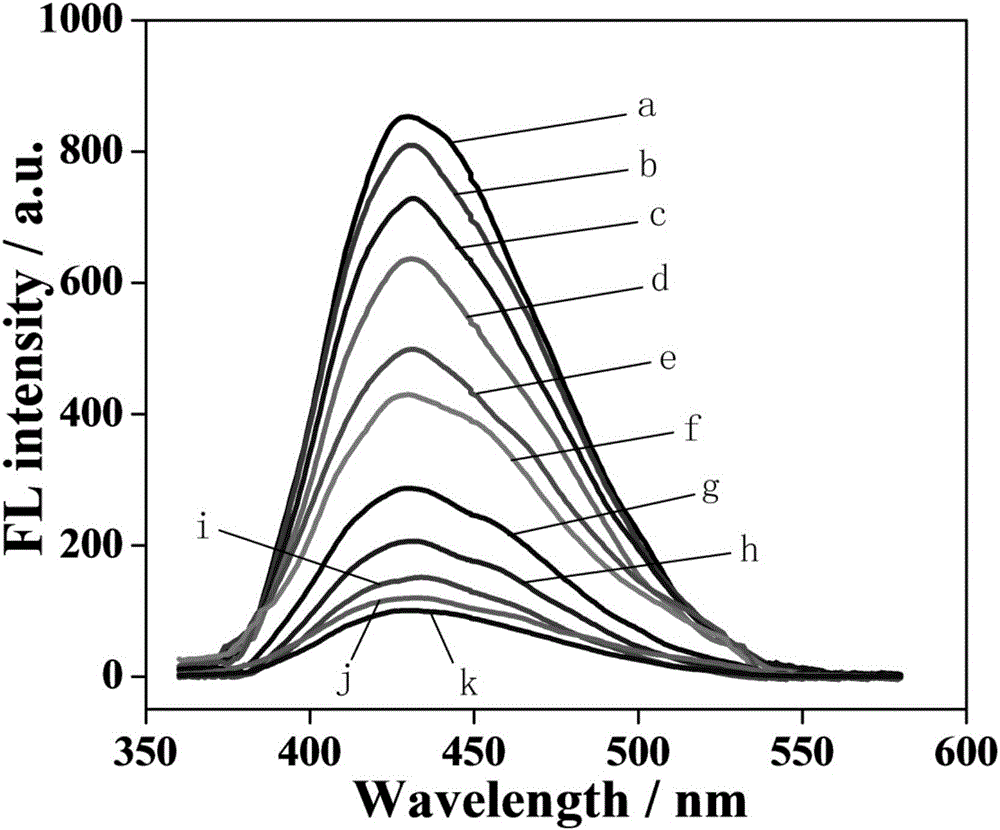Method for producing fluorescence resonance energy transfer sensor and rapidly detecting CaMV35S
A fluorescence resonance energy and detection method technology, applied in fluorescence/phosphorescence, instruments, measuring devices, etc., can solve problems such as complex detection schemes, high detection costs, and low sensitivity, and achieve clear design ideas, fast analysis speeds, and synthetic methods simple effect
- Summary
- Abstract
- Description
- Claims
- Application Information
AI Technical Summary
Problems solved by technology
Method used
Image
Examples
Embodiment 1
[0043] (1) Preparation of NGQDs
[0044] Azagraphene quantum dots (NGQDs) were prepared in one step using the existing thermal cracking method under normal pressure. After mixing 0.5g of ammonium citrate and 15mL of water, they were transferred to a three-necked flask, and the three-necked flask was placed in an oil bath at 200°C. Heating in a pot, a spherical condenser tube is connected to the three-necked flask, and a balloon is tied to the gas outlet of the condenser tube to ensure that the whole process is carried out in a relatively closed and constant pressure environment. As the heating reaction progressed, the balloon began to expand slightly, indicating that ammonia, H 2 O and other gases are generated, and through condensation and reflux, the generated ammonia gas is converted into NH 4 + The form returned to the solution, and the color of the solution gradually changed from colorless to light yellow. With the passage of heating time, the balloon gradually expande...
Embodiment 2
[0056] Construction of standard curve of CaMV35S target DNA by fluorescence resonance energy transfer sensor
[0057] Add 100 μL of CaMV35S target DNA with concentrations of 0.1, 0.5, 1, 5, 10, 50, 100, 200, 400, and 500 nM into 420 μL of prepared NGQDs-probe1, and incubate at constant temperature for 40 minutes, then add 1 mL of prepared Ag-probe2 solution, add NaCl Adjust the sodium ion concentration to 2M, and then continue to incubate for 2 hours to form a sandwich structure of NGQDs-probe1 / tDNA / Ag-probe2, triggering the fluorescence energy resonance transfer from NGQDs to AgNPs, resulting in the quenching of the fluorescence of NGQDs, using fluorescence spectrophotometry Measure the fluorescence intensity of the solution at 355nm, and establish a standard curve between the fluorescence quenching efficiency and the CaMV35S target DNA.
Embodiment 3
[0059] Fluorescence resonance energy transfer sensor detection of actual samples of different content of transgenic soybean:
[0060] Add 100 μL of PCR amplification products containing 0.5%, 1%, and 10% DNA extracts of transgenic soybeans to 420 μL of prepared NGQDs-probe1, and after incubation at constant temperature for 40 min, add 1 mL of prepared Ag-probe2 solution, add NaCl adjusted the sodium ion concentration to 2M, and then continued to incubate for 2 hours to form a sandwich structure of NGQDs-probe1 / tDNA / Ag-probe2, triggering the fluorescence energy resonance transfer from NGQDs to AgNPs, resulting in the quenching of the fluorescence of NGQDs, using fluorescence spectroscopy A photometer measures the fluorescence intensity of the solution at 355nm, and the quenching efficiency is compared with the standard curve to draw a conclusion whether the CaMV35S promoter is contained.
PUM
 Login to View More
Login to View More Abstract
Description
Claims
Application Information
 Login to View More
Login to View More - R&D
- Intellectual Property
- Life Sciences
- Materials
- Tech Scout
- Unparalleled Data Quality
- Higher Quality Content
- 60% Fewer Hallucinations
Browse by: Latest US Patents, China's latest patents, Technical Efficacy Thesaurus, Application Domain, Technology Topic, Popular Technical Reports.
© 2025 PatSnap. All rights reserved.Legal|Privacy policy|Modern Slavery Act Transparency Statement|Sitemap|About US| Contact US: help@patsnap.com

